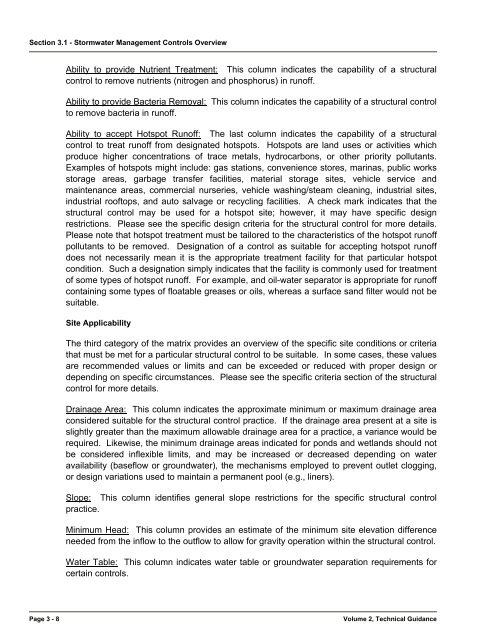Volume 2-05, Chapter 3 - City of Wichita
Volume 2-05, Chapter 3 - City of Wichita
Volume 2-05, Chapter 3 - City of Wichita
You also want an ePaper? Increase the reach of your titles
YUMPU automatically turns print PDFs into web optimized ePapers that Google loves.
Section 3.1 - Stormwater Management Controls Overview<br />
Ability to provide Nutrient Treatment: This column indicates the capability <strong>of</strong> a structural<br />
control to remove nutrients (nitrogen and phosphorus) in run<strong>of</strong>f.<br />
Ability to provide Bacteria Removal: This column indicates the capability <strong>of</strong> a structural control<br />
to remove bacteria in run<strong>of</strong>f.<br />
Ability to accept Hotspot Run<strong>of</strong>f: The last column indicates the capability <strong>of</strong> a structural<br />
control to treat run<strong>of</strong>f from designated hotspots. Hotspots are land uses or activities which<br />
produce higher concentrations <strong>of</strong> trace metals, hydrocarbons, or other priority pollutants.<br />
Examples <strong>of</strong> hotspots might include: gas stations, convenience stores, marinas, public works<br />
storage areas, garbage transfer facilities, material storage sites, vehicle service and<br />
maintenance areas, commercial nurseries, vehicle washing/steam cleaning, industrial sites,<br />
industrial ro<strong>of</strong>tops, and auto salvage or recycling facilities. A check mark indicates that the<br />
structural control may be used for a hotspot site; however, it may have specific design<br />
restrictions. Please see the specific design criteria for the structural control for more details.<br />
Please note that hotspot treatment must be tailored to the characteristics <strong>of</strong> the hotspot run<strong>of</strong>f<br />
pollutants to be removed. Designation <strong>of</strong> a control as suitable for accepting hotspot run<strong>of</strong>f<br />
does not necessarily mean it is the appropriate treatment facility for that particular hotspot<br />
condition. Such a designation simply indicates that the facility is commonly used for treatment<br />
<strong>of</strong> some types <strong>of</strong> hotspot run<strong>of</strong>f. For example, and oil-water separator is appropriate for run<strong>of</strong>f<br />
containing some types <strong>of</strong> floatable greases or oils, whereas a surface sand filter would not be<br />
suitable.<br />
Site Applicability<br />
The third category <strong>of</strong> the matrix provides an overview <strong>of</strong> the specific site conditions or criteria<br />
that must be met for a particular structural control to be suitable. In some cases, these values<br />
are recommended values or limits and can be exceeded or reduced with proper design or<br />
depending on specific circumstances. Please see the specific criteria section <strong>of</strong> the structural<br />
control for more details.<br />
Drainage Area: This column indicates the approximate minimum or maximum drainage area<br />
considered suitable for the structural control practice. If the drainage area present at a site is<br />
slightly greater than the maximum allowable drainage area for a practice, a variance would be<br />
required. Likewise, the minimum drainage areas indicated for ponds and wetlands should not<br />
be considered inflexible limits, and may be increased or decreased depending on water<br />
availability (baseflow or groundwater), the mechanisms employed to prevent outlet clogging,<br />
or design variations used to maintain a permanent pool (e.g., liners).<br />
Slope: This column identifies general slope restrictions for the specific structural control<br />
practice.<br />
Minimum Head: This column provides an estimate <strong>of</strong> the minimum site elevation difference<br />
needed from the inflow to the outflow to allow for gravity operation within the structural control.<br />
Water Table: This column indicates water table or groundwater separation requirements for<br />
certain controls.<br />
Page 3 - 8<br />
<strong>Volume</strong> 2, Technical Guidance
















